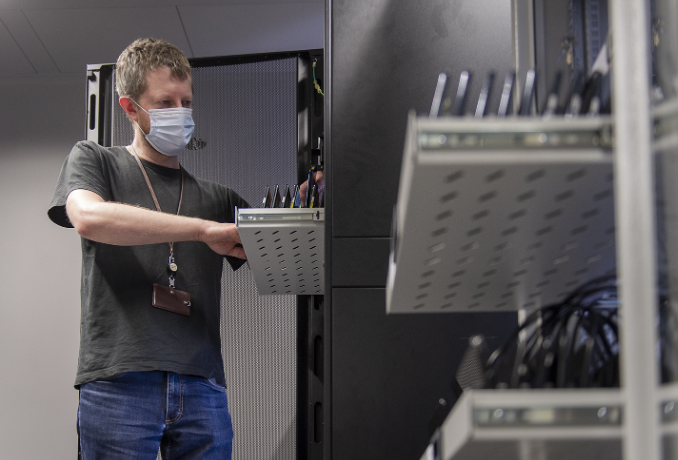Setting Up A Remote Test Lab – Key Considerations
Testing apps swiftly and effectively is crucial in the fast-changing world of software development. Due to their scalability, flexibility, and cost-effectiveness, a remote test lab can replace on-premises testing facilities. Team members may test devices, browsers, and operating systems in a remote test lab without physical infrastructure. Today’s remote teams require smooth testing environment access, therefore, this configuration is ideal.
However, setting up a remote test lab requires careful preparation and consideration of various variables. From choosing the right tools and technologies to implementing strong security measures, each choice may affect testing productivity.
This article covers infrastructure, tools, security, and other crucial aspects of setting up a remote test lab. Understanding these factors allows firms to construct a remote test lab that fulfills current testing requirements and grows with future needs, resulting in higher-quality software and quicker time-to-market.
Remote Test Lab: Let’s Understand!
Software development teams may test their apps on every device, browser, and operating system in a remote test lab. Remote test laboratories use cloud-based technology for flexibility and scalability without major physical resources. This configuration simplifies continuous testing and integration for distant teams to collaborate and produce high-quality software.
Importance Of A Remote Test Lab
Here is the importance of a remote test lab –
- Flexibility and Accessibility: Remote test laboratories enable testers and developers to test from anywhere. Today’s multinational workplace requires this flexibility since team members may be located elsewhere. Remote access allows testing to continue regardless of team location.
- Scalability: It is a major benefit of remote test labs. Additional resources may be added without hardware as testing needs arise. Scalability allows the testing environment to accommodate additional test cases, devices, and concurrent users as the project demands change.
- Cost-effectiveness: On-premises testing requires significant hardware, software, and maintenance costs. Instead, remote test laboratories use cloud-based resources that may be scaled up or down, saving money. Without physical infrastructure, organizations may save money.
- Enhanced Collaboration: Remote test laboratories provide a common platform for managing and monitoring testing operations, improving team cooperation. A centralized strategy ensures everyone is on the same page, avoiding communication gaps and enhancing productivity. Remote test labs commonly include version control, issue tracking, and test management tools to streamline productivity.
- Comprehensive Testing: With access to many devices, browsers, and operating systems, remote test laboratories provide thorough testing across settings.
This thorough technique finds and fixes configuration-specific errors, making software more resilient and dependable.
- Faster Time-to-Market: Remote test laboratories provide continuous testing and integration, speeding up development. Teams may find and fix bugs early in development, saving time for testing and debugging. This efficiency speeds up releases and time-to-market for new features and upgrades.
In essence, a remote test lab is essential to contemporary software development, enabling flexibility, scalability, and cost-effectiveness for high-quality programs. Remote test laboratories help organizations fulfill their testing needs quickly and effectively by using cloud-based infrastructure and allowing seamless collaboration, resulting in better software and customer satisfaction.
Benefits Of Remote Testing Environments
Software development teams use remote testing environments for their many advantages. These include flexibility, cost savings, improved cooperation, and advanced testing. Remote testing environments provide certain advantages:
1. Flexibility and Accessibility
- Global Access: Team members can access the testing environment from anywhere in the world, allowing for a truly global workforce. This flexibility is particularly valuable for organizations with distributed teams.
- 24/7 Availability: Remote testing environments can be accessed at any time, enabling continuous testing and reducing downtime. Testing may continue uninterrupted across time zones with its availability.
2. Scalability
- Resource Management: Project-specific remote testing environments may be scaled up or down. This scalability lets teams manage different workloads without investing in physical equipment.
- Elastic Resources: Cloud-based remote labs offer elastic resources that can be dynamically adjusted, ensuring optimal performance and cost efficiency.
3. Cost Savings
- Cloud resources reduce infrastructure expenses: Organizations may avoid the high upfront costs of acquiring and maintaining physical hardware.
- Pay-As-You-Go: Many remote testing providers offer pay-as-you-go pricing, letting firms pay only for the resources they utilize. This model helps in managing budgets more effectively.
4. Enhanced Collaboration
- Centralized Platform: Remote testing environments centralize testing management and monitoring. Centralization improves teamwork and communication.
- Integrated applications: Many remote laboratories incorporate popular version control, bug tracking, and test management applications to streamline processes and boost productivity.
5. Comprehensive Testing
- Diverse Configurations: Remote testing environments offer several devices, browsers, and operating systems, allowing full testing across configurations. This variety helps detect and handle problems unique to certain surroundings.
- Cross-Platform Testing: Teams may test software across platforms for compatibility and performance, improving software quality.
6. Improved Test Coverage
- Automated Testing: Many remote settings provide powerful automation technologies, allowing for comprehensive automated testing. Automation boosts test coverage and identifies flaws early in development.
- Parallel Testing: Running tests on many setups simultaneously speeds up and assures coverage.
7. Faster Time-to-Market
- Continuous Integration and Delivery: Remote testing environments enable CI/CD, speeding development cycles. Teams can easily find and address problems, speeding up releases.
- Reduced Bottlenecks: Remote testing environments decrease bottlenecks and simplify testing by offering on-demand resources and removing physical setups.
8. Enhanced Security and Compliance
- Secure Access: Remote labs protect sensitive data with secure access restrictions and encryption.
- Compliance: Many remote testing organizations assist firms satisfy GDPR and HIPAA compliance requirements.
Remote testing environments improve software testing productivity, flexibility, and cost. By using cloud-based resources and innovative technologies, firms may increase software quality, collaboration, and time-to-market, improving user experiences and competitiveness.
Setting up a remote test lab requires a platform with extensive testing capabilities, simplicity of use, and strong support. LambdaTest is a cloud-based testing platform that lets developers and testers automate and manually test across browsers, OSes, and devices.
With over 3,000 genuine browsers and devices, LambdaTest tests your apps in varied contexts. This thorough coverage helps detect compatibility concerns early, making the product more robust and user-friendly.
Popular Continuous Integration/Continuous Deployment (CI/CD) systems like Jenkins, CircleCI, GitLab, and others are easily integrated with LambdaTest. Code modifications are swiftly verified and validated thanks to this integration’s ability to provide continuous testing and immediate feedback.
LambdaTest facilitates the integration of well-known automation frameworks like Appium, Cypress, and Selenium, allowing you to expedite your testing process by automating repetitive tests. You may run many tests concurrently on the platform thanks to its parallel testing features, which greatly cuts down on testing time.
Selecting The Right Tools For Remote Test Lab: Let’s Set It Up!
Choosing the correct remote test lab equipment and technology is essential for effective and thorough testing. Tools affect test management, automation, interaction with other development tools, and workflow efficiency in the test lab.
- Testing efforts must be organized and tracked using test management technologies. Making, running, and monitoring test cases using these tools ensures that the whole application is tested. Popular test management platforms like TestRail, Zephyr, and qTest provide team communication, real-time reporting, and issue tracking system integration.
- Automation tools and frameworks are another critical component. They automate repeated testing, saving time and decreasing mistakes. Selenium, Appium, and Cypress are popular automation tools for several platforms and languages. These tools produce solid test scripts that may be reused and updated, improving testing efficiency.
- Also important is integration with CI/CD workflows. Jenkins, CircleCI, and GitLab CI integrate testing with development and deployment operations. This integration automatically triggers tests with every code change, giving rapid feedback and enabling speedy problem discovery and resolution.
- To safeguard sensitive data and comply with regulations, technologies that enable secure access controls, encryption, and industry standards are essential. Okta for identity management and VeraCrypt for encryption protect testing environments.
- Monitoring and analytics technologies like New Relic and Datadog may also be used to assess test lab performance and dependability. These technologies detect bottlenecks and optimize resource utilization, delivering a smooth testing environment.
The development team’s requirements and processes must be considered when choosing remote test lab tools and technology. Organizations can build a remote test lab that improves software quality, testing efficiency, and time-to-market by using robust test management tools, automation frameworks, seamless CI/CD integration, comprehensive cross-browser testing solutions, and strong security measures.
Common Challenges In Setting Up A Remote Test Lab
The remote test lab setup presents various issues that might reduce efficiency and effectiveness. To create a dependable testing environment, you must understand these difficulties and develop solutions.
- A major obstacle is making sure that the network is consistently connected. In order to access cloud-based resources and enable communication between team members, a remote test lab substantially depends on an internet connection.
Slow or unstable internet connections may cause testing to be difficult, which can cause delays and lower productivity. Having a fast, dependable internet connection is crucial to reducing this, and you should think about using network optimization tools to improve connections.
- Security concerns are another significant challenge. Sensitive data must be secured against cyber risks and illegal access, as remote testing includes accessing and transferring it.
It is crucial to make sure that strong security measures, such as encryption, safe access restrictions, and adherence to industry standards (like GDPR and HIPAA), are in place. The testing environment may be protected by conducting regular security audits and putting security best practices into effect.
- Resource allocation and management pose additional difficulties. Remote test laboratories must effectively manage virtual machines, containers, and other resources in order to avoid bottlenecks and guarantee peak performance.
This involves careful planning and monitoring to allocate resources effectively based on the testing workload. This procedure may be made more efficient by using automated resource allocation and resource management systems.
- It might be difficult to integrate new processes and technologies with current ones. Version control systems, other development tools, and the organization’s current CI/CD pipelines must all work in unison with a remote test lab.
Extensive preparation and testing are necessary to guarantee compatibility and seamless integration. Choosing tools that offer broad compatibility and strong integration capabilities can alleviate this challenge.
- Remote teams might struggle with cooperation and communication. Remote team members need good communication and collaboration tools to operate well together. Slack, Microsoft Teams, Zoom, and collaborative systems for test management and documentation help improve cooperation and coordination.
- Continuously changing the test environment is another difficulty. Regular maintenance keeps software and gear in a remote test lab working properly. Patching, upgrading software, and monitoring testing infrastructure performance are included. Automated monitoring and updating technologies save human labor and downtime.
- Finally, cost control might be difficult for smaller organizations with limited expenditures. While cloud-based remote test laboratories might be cost-effective, use and resource demands can raise prices. Pay-as-you-go models, budget constraints, and frequent use and cost reviews may help reduce expenditures.
In conclusion, remote test labs need a network connection, security, resource management, integration, team cooperation, maintenance, and cost management. By anticipating and addressing these issues, organizations may create a safe, efficient, and competent remote test lab.
Final -Words!
A smart approach that may greatly improve the efficacy, scalability, and affordability of software testing procedures is setting up a remote test lab. The advantages of network connection exceed the drawbacks, even with regard to security, resource management, integration, teamwork, maintenance, and cost control. With the unmatched accessibility and flexibility that remote test laboratories provide, scattered teams may work together easily and conduct tests in a variety of settings.
Organizations may overcome the main problems of setting up a remote test lab by carefully choosing the correct tools and technologies, making sure that security measures are strong, and putting effective resource and expense management methods into place. This configuration speeds up time-to-market and facilitates thorough, continuous testing, which eventually results in better products and happier users.
A well-thought-out and functional remote test lab is a vital tool for every progressive software development team in an age when remote work and international cooperation are the norm. It helps organizations to maintain their competitiveness, agility, and responsiveness to the market’s constantly shifting expectations while guaranteeing that their applications satisfy the highest requirements for performance and quality.






